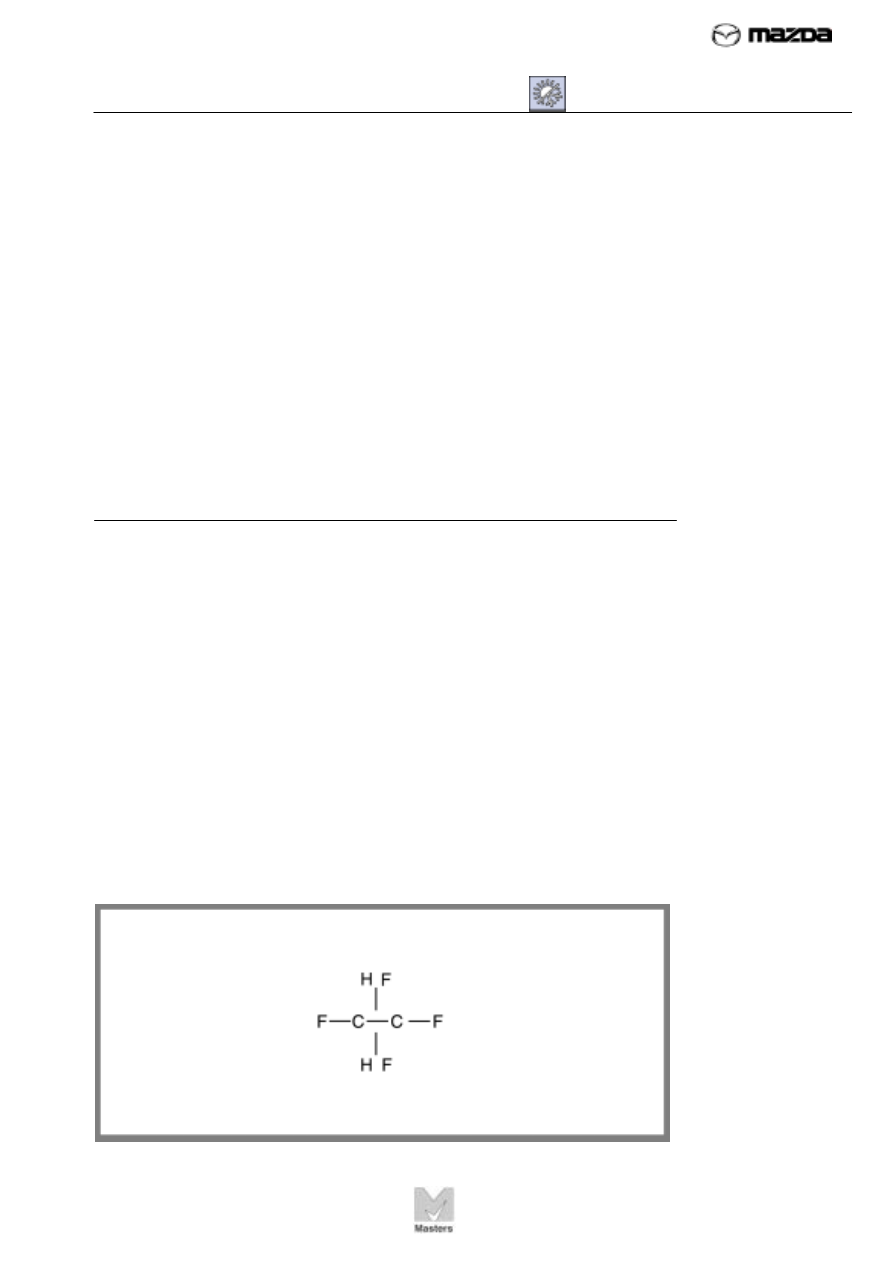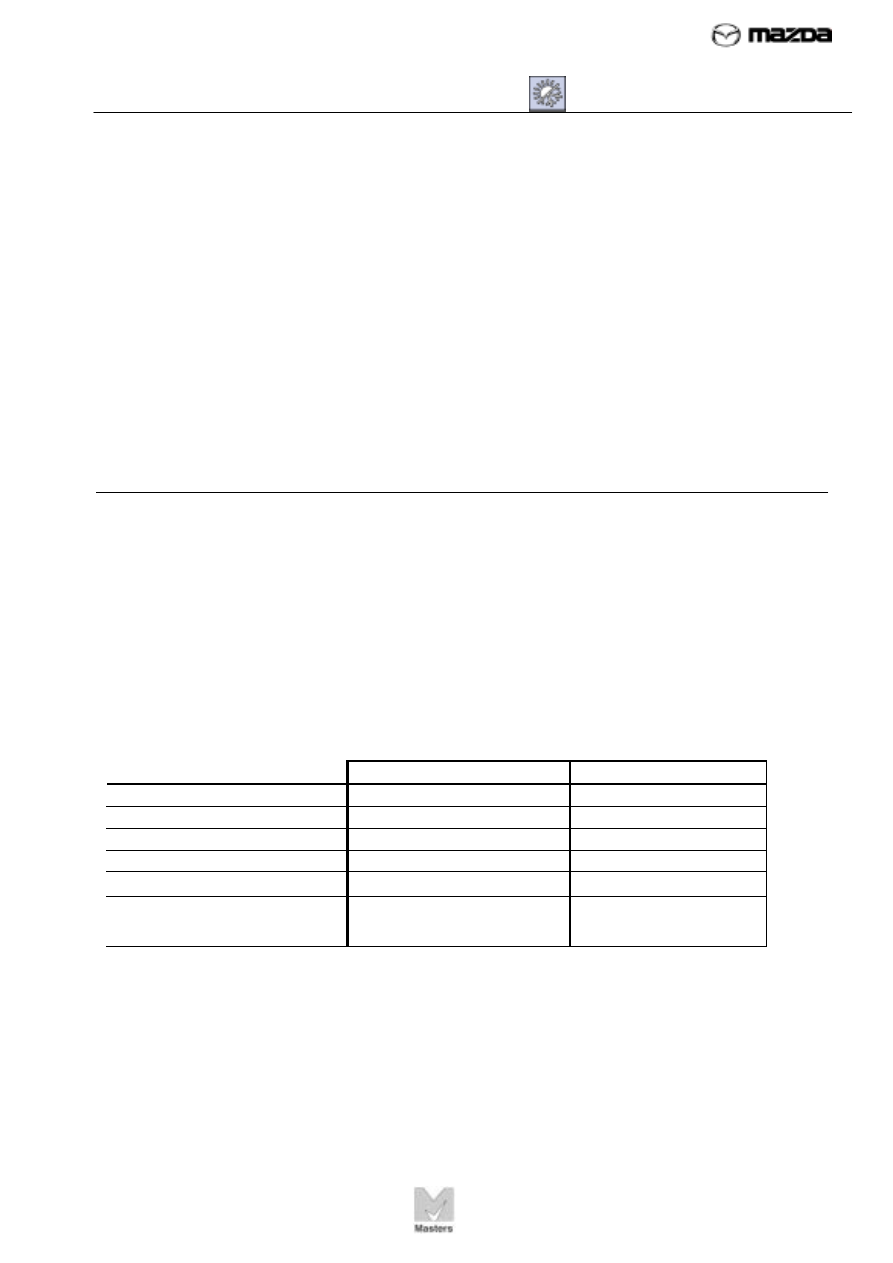Mazda Training manual — part 269

Air Conditioning Fundamentals
TC070-05-01S
7 – REFRIGERANTS
50
In the mid-1980s, scientists discovered that chemicals called
chloro-fluorocarbons (CFCs) were destroying the ozone in the
atmosphere. Ozone protects the earth from harmful ultraviolet rays
released by the sun.
One of the major contributors to CFCs in the atmosphere was R-12,
which often leaked into the atmosphere during servicing of A/C systems.
In 1987, the United States and 22 other countries signed an
international agreement calling for the gradual phase-out of CFCs.
In 1990, the United States revised the federal Clean Air Act, adding
stricter CFC standards than the international agreement. As a result,
R-12 was phased out of most automotive A/C systems in about 1990.
By the year 2000, R-12 will be banned completely.
HFC134a (R-134a)
Because of the environmental damage caused by R-12, scientists
developed an alternative refrigerant called R-134a. Most vehicles
manufactured from 1990 to the present use R-134a as an A/C
refrigerant.
Chemical Structure
R-134a is the common name for Tetrafluoroethane-134a (HFC-134a),
whose chemical formula is CH2FCF3. Unlike R-12, R-134a does not
contain CFCs. Instead, it contains hydrofluorocarbons (HFCs), which do
not damage the ozone layer.
Figure 29 shows the chemical structure of R-134a, which contains two
carbon atoms, two hydrogen atoms, and four fluorine atoms.
FIGURE 29. R-134
contains carbon,
hydrogen, and
fluoride atoms. It is
used as a refrigerant
in most vehicles built
from 1990 to the
present.

Air Conditioning Fundamentals
TC070-05-01S
7 – REFRIGERANTS
51
Properties of R-134a
Like R-12, R-134a has chemical properties that make it ideal for use as a refrigerant. These
include:
•
Low boiling point of -15° F (-26° C) at sea level.
•
Ability to change temperature readily in response to changes in pressure.
R-134a provides most of the benefits of R-12 without the harmful atmospheric effects. The
absence of chlorine in R-134a makes it environmentally “friendly,” but R-134a can be
flammable under certain pressures and concentrations. For more information about these
conditions, see “Safety Procedures” on page 57.
DIFFERENCES BETWEEN REFRIGERANTS
A/C systems that use one type of refrigerant cannot use the other type. For example, you
cannot use R-134a to charge an older A/C system designed to use R-12. (Some older
systems can be retrofit to use the new refrigerant, but these are special cases. See
“Retrofitting” on page 56.)
Under no circumstances can you mix R-12 and R-134a in the same system. Mixing
refrigerants is called cross-contamination, and it can seriously damage the A/C system. In
addition, identifying contaminated refrigerant during normal diagnosis is difficult.
The chart below outlines the differences between the two refrigerants. Whenever you work
on an A/C system, you must determine the refrigerant type.
R-12
R-134a
Container color
White
Light blue
Container marking
R-12 R-134a
Container fitting size
7/16" - 20; 1/4" flare
1/2" - 16 ACME
Chemical name
Dichlorodifluoromethane
Tetrafluoroethane
Boiling point
-21.62° F (-29.70° C)
-15.07° F (-25.15° C)
Latent heat of vaporization
36.43 BTUs @ 32° F (0°
C)
47.19 BTUs @ 32° F
(0° C)

Air Conditioning Fundamentals
TC070-05-01S
7 – REFRIGERANTS
52
To prevent cross-contamination, always observe the following rules:
1. Refer to the tags or bands around the lines and tubes to identify the refrigerant used in
the system.
2. Do not mix R-12 and R-134a service equipment.
3. Do not use adapters to cross from one refrigerant to the other.
4. You may use new R-134a rubber seals and hoses on an R-12 system. However, you
may not use R-12 rubber seals and hoses on an R-134a system.
RECYCLED, RECLAIMED, AND EXTRACTED REFRIGERANT
Technicians often remove (discharge) refrigerants from an A/C system during service.
Depending on how these refrigerants are processed after removal, they are called recycled,
reclaimed, or extracted.
Recycled Refrigerant
Recycled refrigerant is cleaned to remove contaminants produced during normal operation
of a mobile A/C system. Mixing recycled refrigerant from a non-mobile system — a building
A/C system, for example — will contaminate recycled mobile refrigerant.
Reclaimed Refrigerant
Reclaimed refrigerant is processed to the same standards and purity as new refrigerant.
This process requires expensive equipment not ordinarily found in dealership service
departments.
Reclaimed and recycled refrigerant will perform equally well in all mobile A/C systems.

Air Conditioning Fundamentals
TC070-05-01S
7 – REFRIGERANTS
53
FIGURE 30. A
container filled to 60
percent capacity at
50° F (10° C) poses
no safety hazard.
However, the same
container at 90° F
(32° C) reaches its
maximum capacity.
At 100° F (38° C),
high pressure in the
container can cause
an explosion.
Extracted Refrigerant
Extracted refrigerant is simply removed and stored in an approved
container, without any filtering or processing. Before you return
extracted refrigerant to a vehicle A/C system, you should recycle it to
remove impurities.
STORING RECYCLED REFRIGERANT
Both R-12 and R-134a are gases at normal room temperature, and they
can be hazardous if stored improperly. New refrigerant stored in its
original, properly filled container usually poses no safety hazard.
However, recycled refrigerant can be dangerous if it is stored in the
wrong type of container or in an overfilled container.
To prevent accidents when handling recycled refrigerant, always follow
the rules below:
1.
Never save disposable refrigerant containers for reuse. Remove all
refrigerant and dispose of the containers properly.
2. Use only containers approved by the U.S. Department of
Transportation. Approved containers are marked “DOT4BA” or
DOT4BW.”
3. Never fill a container to more than 60 percent of its capacity.
4. Never store refrigerant containers in direct sun or heat. High
temperature causes the gas to expand, which increases the
pressure in the container. Figure 30 shows what can happen if a
properly filled container reaches a temperature of 100° F (38° C).
50° F
90° F
100° F
60% capacity 100% capacity

Нет комментариевНе стесняйтесь поделиться с нами вашим ценным мнением.
Текст